Comparison of the Top 15 On Demand Video Streaming Solutions [2021 Update]
As a broadcaster, on-demand video streaming is a very valuable tool. This method of video delivery is also known as “video on demand” or “VOD.” It can be used in many different ways, including online education, marketing, sales, and more.
In order to make the most of your VOD content, you’ll need the support of an on-demand video streaming platform. This sort of solution will give you access to the features you need for a professional broadcasting experience.
In this post, we’ll discuss what broadcasters need to know about on-demand video streaming. We’ll walk you through the process of choosing the right VOD platform by reviewing the key features to look for in an on-demand video streaming solution. From there, we will compare the top 15 video-on-demand streaming software options.
Table of Contents:
- What is On-Demand Video Streaming?
- Live Streaming vs. On-Demand Video Streaming
- Top Tools for On-Demand Video Streaming
- Comparing 15 Top On-Demand Video Streaming Solutions
- Conclusion
What is On-Demand Video Streaming?
On-demand video streaming is a popular method of delivering video content online that allows viewers to access content any time they want.
From instructional fitness videos to recorded lectures, VOD gives viewers the ability to select the video they want to watch even years after it’s created, broadening your content’s overall reach long-term.
Rather than having to ensure they’re watching right when you live stream, VOD fits the schedule of the viewers and even allows them to re-watch videos they may want to see again.
Since video-on-demand streaming gives your content a longer lifespan, it also increases the potential revenue you can earn with video monetization.
Live Streaming vs. On-Demand Video Streaming

VOD and live streaming are the two popular delivery methods for online video streaming. While both VOD and live content are indeed streamed over the internet, the similarities stop there. The differences between on-demand and video streaming are not intricate, but they are significant.
Live streaming means that content is playable as it’s created, or with a very small delay, going directly from your camera to the user’s screen. This immediate consumption means that live-streamed video often is less highly produced than other content.
If viewers miss a live stream that isn’t recorded and distributed in another manner, such as using VOD, then they miss out on the content. Additionally, many live streams have limited or non-existent pause and rewind features, causing viewers to miss out on potentially important or interesting information.
VOD, on the other hand, makes video content available to viewers at any time they choose, on any device. Whether it’s hours, weeks, or even years after a piece of content is first uploaded, as long as it is located somewhere on the internet, viewers can find and watch the video.
They can pause, rewind, replay, and rewatch all or portions of the content. VOD content also has the option to be more polished, as producers can edit their videos before uploading them for viewing.
VOD also has the benefit of taking live streamed content and making it accessible on an on-demand basis, allowing those who missed the live stream to catch up. Live to VOD streaming is made possible with a live stream recording tool.
Top Tools for On-Demand Video Streaming
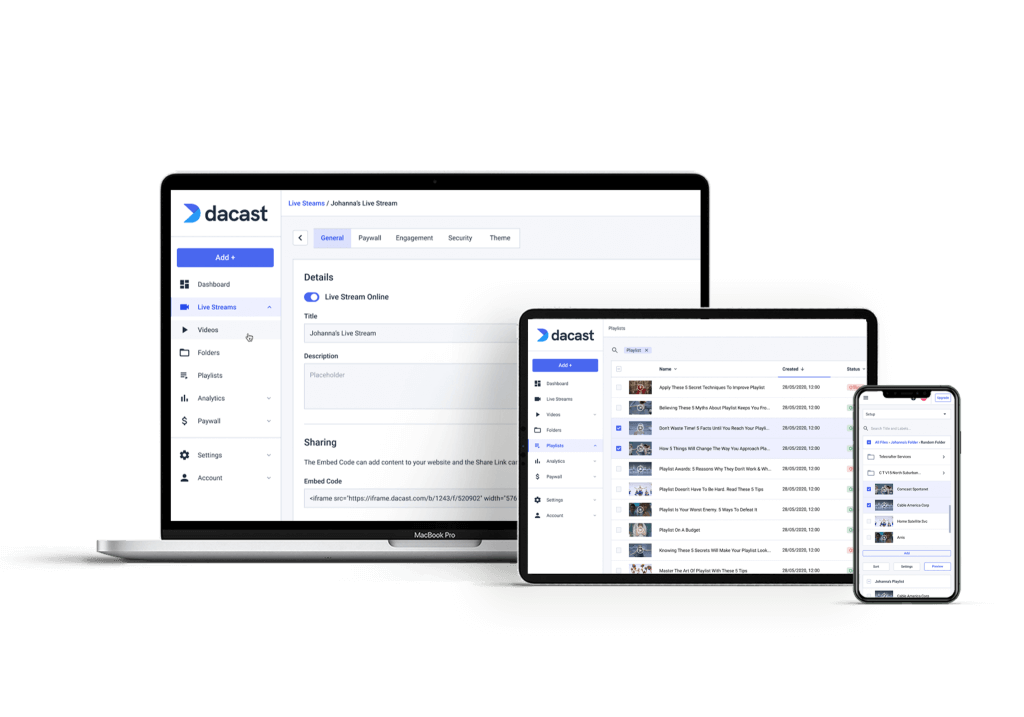
Not all on-demand streaming platforms are created equal. Each has its own unique features at different price points, but there are five key features you should look for as you compare options. These include:
- Video CMS
- Transcoding
- Video monetization
- White-label video player
- Video privacy and security
Let’s take a closer look at each of these features and discuss why they are important for on-demand video streaming.
1. Video CMS
A robust video content management system (CMS) is an essential feature for VOD streaming at the professional level. A video CMS includes professional video hosting tools for managing, and organizing content.
Part of being able to effectively share your on-demand video streaming content is keeping it all well-organized and individually tagging all your videos. This way, if a user searches for a video on a specific topic, your video is much easier for them to find and you are more likely to get that viewer.
Tagging by category and subcategory also allows for the creation of smart playlists, which suggest to viewers other videos related to those they’re already watching. This keeps people on your website, watching your content longer than if your video CMS did not have this functionality.
2. VOD Transcoding
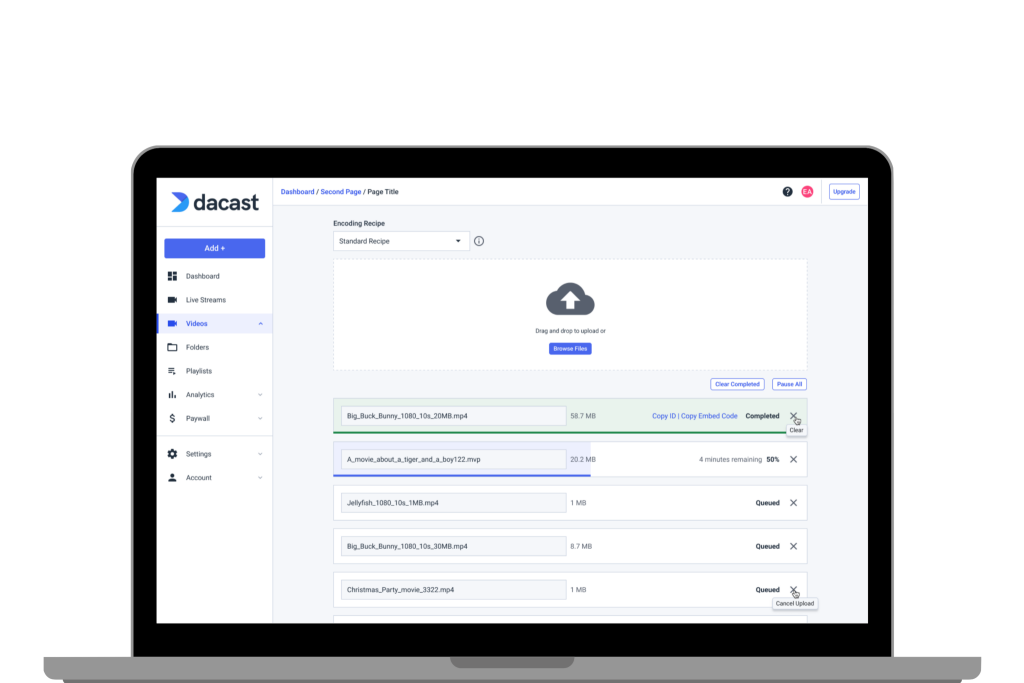
The file size that plays well on the desktop computer of someone watching with a stable internet connection is not going to be the file size that will play smoothly on a mobile device with spotty WiFi.
Transcoding your video allows you to create multiple video renditions that are of different sizes. This allows your videos to play at the highest quality necessary for each viewer’s device needs.
With automatic VOD transcoding, your VOD streaming platform creates separate files without you having to manually save each version. Choose a platform that supports automatic transcoding so that you can create the best user experience for every viewer.
3. Video Monetization
One of the perks of offering your content on-demand is the ability to monetize your videos in the manner you choose.
A well-equipped on-demand streaming software supports different video monetization methods, including SVOD, TVOD, or AVOD. It should also offer an integrated paywall solution for users to submit online payments and for you to securely collect revenue.
Subscription Video on Demand (SVOD)
With SVOD monetization, viewers pay a subscription fee that allows them to watch as much of your content as they desire. Popular platforms, like Netflix, Disney+, and ESPN+ use this model.
Subscriptions are typically charged on a monthly, quarterly, or annual basis.
Transactional Video on Demand (TVOD)
If you have specific videos or video series you want to monetize, TVOD, or pay per view streaming, is likely the best model for you.
With this model, viewers pay a set price for access to each video or series of videos, and you can set different price points for bundles of content. Typically, access is limited to a set period of time.
Ad-Based Video on Demand (AVOD)
Some creators choose to make their content free for viewers to access but elect to monetize that content by showing advertisements during the video. This is called AVOD monetization.
4. White-Label Video Player
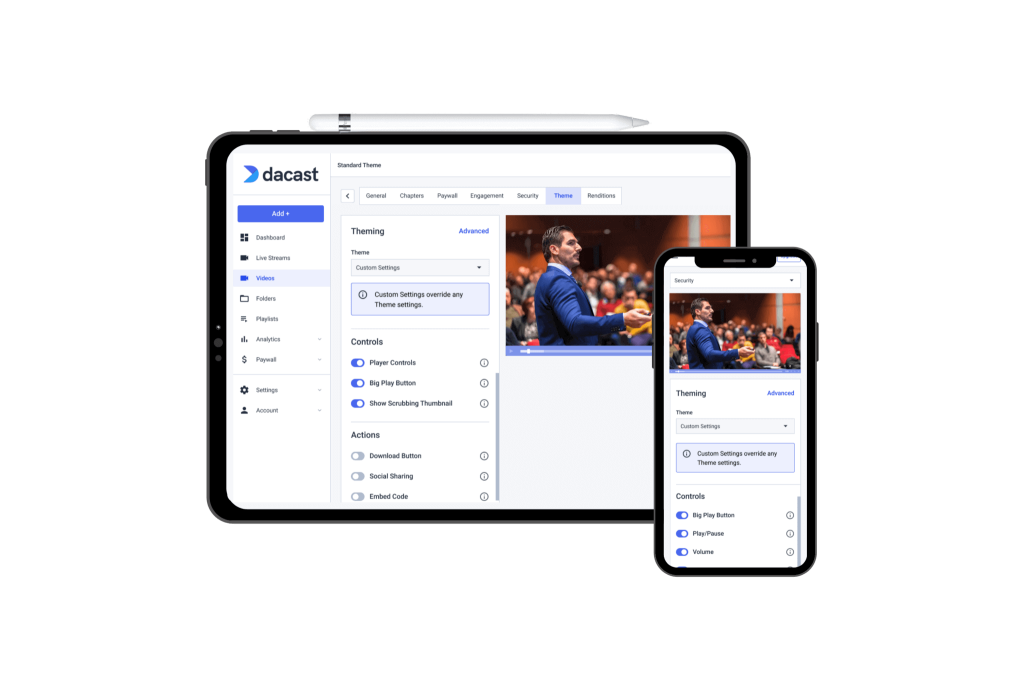
Hosting VOD content may feel overwhelming. It might come off as overly technical or complicated. This is why plug-and-play platforms such as YouTube appeal to so many content creators.
However, when using a free platform, you’re at the mercy of that platform and how it decides to distribute your content. You have no control over the advertisements that are played, what videos are suggested to viewers and more, and your videos will be marked by the logo and branding of the site.
If you want to embed and share videos on your own website, customize your HTML5 video player, or on social media, you may be limited.
By choosing a VOD platform with a white-label video player, you have the ease of these plug-and-play platforms but greater control over their distribution.
White-label streaming allows you to replace the third-party branding on your videos with your own logo, keeping your branding consistent across all platforms. This also allows you to embed an HTML5 video player into your website and easily share it on social media.
5. Video Security
Trust is huge when you want your viewers to keep coming back to view your content, and you need the help of a secure on-demand video streaming platform to help build that trust.
Thanks to HTTPS secure uploading and delivery, you can give your users peace of mind that their devices are safe when they’re viewing your content and submitting payments online through integrated paywalls.
Also, video security helps to protect you against video piracy, which is at an all-time high.
Comparing 15 Top On-Demand Video Streaming Solutions
With these five key features in mind, let’s take a look at 15 of the top professional-grade live and on-demand video streaming platforms.
1. Dacast
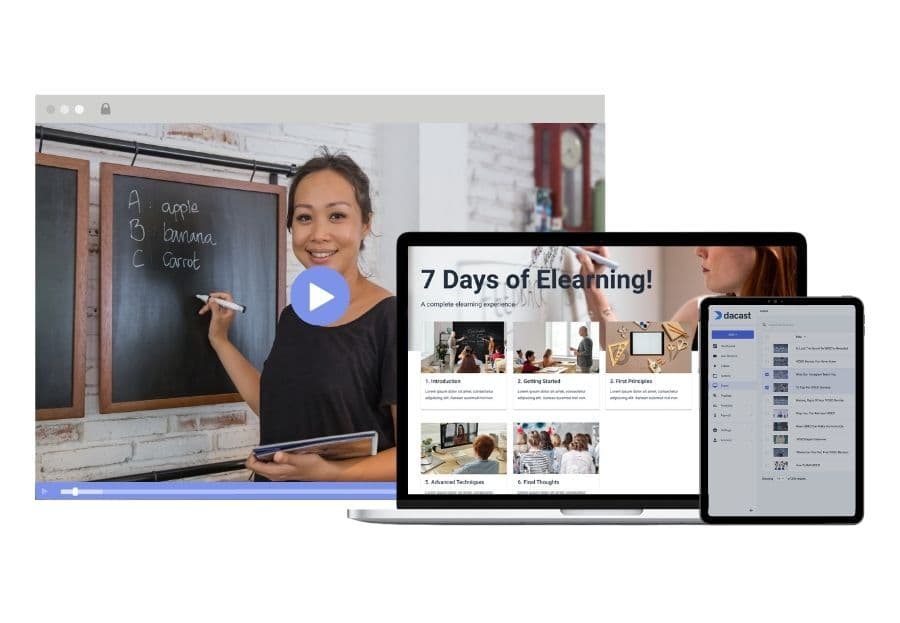
Basic Functionality:
Dacast offers comprehensive live streaming and on-demand video hosting solutions. Users are able to embed videos on their own websites, retaining complete control of their content. Some of the key features of Dacast include an integrated paywall, password protection, an analytics dashboard, and referrer restriction.
Key Features:
- Both live streaming and VOD packages for all pricing plans
- 24/7 tech support with all plans, including email and live chat
- RTMP Encoder for ingesting HLS streaming
- Player API access for 3rd party player integration
- Video API access on premium plans (scale and event)
- Adaptive multi-bitrate streaming
- Multi-bitrate streaming
- Secure, global content delivery, as well as industry-best video hosting
- Video security features, including password protection and encryption
- Ad-free streaming
- Real-time analytics
New!
- Multi-user access on Scale and Custom plans
- Zoom live streaming integration for meetings and live events in real-time
- Expo 2.0 galleries video portal for immersive video experiences
Pros:
- Unlimited viewers and live channels
- Live stream recording
- China Video Hosting
- Plans for every budget
- White label and branding control
- SVOD, AVOD, and TVOD monetization options
- Embeddable HTML5 video player
- Mobile device support
Cons:
- Figuring out all available features can take some time
Upload Guidelines and Specs:
- Minimum dimension: none (but 240p is the recommended minimum)
- Maximum dimension: 1080p or 4K (depends on the user’s hardware and internet)
- Aspect ratio: no restrictions (but 16:9 is the default)
- Max file size: none
- Max video length: none
- Total file storage: 10-1000GB (depends on plan)
- Compatible video formats: MP4 (preferred), MOV, M4V, M2V, AVI, MPG, FLV, WMV, MKV, WEBM, OGV, MXF, ASF, VOB, MTS
Pricing:
There are three levels of live streaming pricing plans with Dacast: Starter, Scale, and Event.
- Starter plan: ideal for newcomers with 1,000 TB of bandwidth and 50 GB of storage per month, at just $39 per month billed annually.
- Scale plan: includes 24 TB of bandwidth per year, with 1 TB of storage for $188 per month billed annually. These Scale pricing plans add phone support, monetization paywall, an M3U8 online player for live channels, ad insertion, white-label Cnames, and video API access.
- Event plan: for organizations who’d rather not sign a contract, and want to purchase bandwidth separately to live stream an event. It offers 6 TB of bandwidth upfront, 50 GB of storage, and costs just $63 per month (or $750/year). Additional data and storage can be added as needed.
- For those creators who need more storage, greater bandwidth, or large amounts of viewing capacity, Dacast does offer custom-priced high-volume plans. Please contact us for more information.
2. IBM Cloud Video (formerly UStream)

Previously known as UStream, IBM Cloud Video offers both live streaming and VOD streaming. It is considered reliable but is among the more expensive options on the market, so it is better suited for enterprises and organizations with large budgets.
Basic Functionality:
IBM Cloud Video offers hosting solutions for both live streaming and on-demand video.
Key Features:
Key elements of the IBM Cloud Live Video solution include:
- Streaming up to 720p resolution (*only Enterprise plans support 1080p full HD streaming)
- Mobile-compatible video player
- White-label custom branding (with high-end plans)
- Uses IBM internal CDN to distribute content
- API available (with high-end plans)
Pros:
- Great for professional broadcasters, with lots of professional features
- Perfect for larger clients
- Reliable, helpful technical support
- Hong Kong (China) video hosting
Cons:
- Only offers ad-based monetization
- Expensive, so not suited for businesses and organizations with smaller budgets
- Some limitations with the internal content delivery server
- Some important features are only available with the most expensive plans
Upload Guidelines and Specs:
- Minimum dimension: 480p (480 x 270)
- Maximum dimension: 4K (3840 x 2160)
- Aspect ratio: No published aspect ratio
- Max file size: 4 GB
- Max video length: No published limits
- Total file storage: 1TB – 5TB (depends on plan)
- Compatible video formats: MKV, MP4, MOV, FLV, AVI, WMV, MPEG2, H264, H263, MPEG4, VP6, VP8, THEORA, WMV, MP3, AAC-LC, NELLYMOSER, PCM, SPEEX, VORBIS, WMA
Pricing:
IBM Cloud Video offers three levels of plans:
- Silver: $99/month
- Gold: $499/month
- Platinum: $999/month
- Custom: Please contact IBM Cloud video for custom plan pricing.
3. Vimeo

Vimeo’s name may seem familiar from its days as a B2C platform similar to YouTube. Now, it serves a professional clientele and offers both live streaming and VOD.
Basic Functionality:
Vimeo is a widely accessible, easy-to-use streaming video-on-demand software.
Key Features:
- Editing features included
- Pay only for what you use
- Pay-per-view and subscriptions available
- Ad-free streaming
- Easy-to-use API
- Analytics built-in
Pros:
- User-friendly
- Options for monetization
- Customizable video players
- VOD and live streaming
- Built-in transcoding
Cons:
- Monetizing your content costs up to 10% of your revenue
- Add-on features can get expensive
- No China video delivery
Upload Guidelines and Specs:
- Recommended dimension: 720p (1280 x 720)
- Aspect ratio: 16:9, 4:3
- Max file size: 3GB
- Max video length: Information not available
- Total file storage: Information not available
- Compatible video formats: MP4 (recommended)
Pricing:
Vimeo offers basic video hosting plans that are suitable for content creators and startups.
- Basic: 30-day free trial
- Plus: $7/month; 5GB/week or 250GB every year; Single user; Brand customization and privacy tools
- Pro: $20/month; 20GB/week or 1TB every year; 3 users; collaboration tools and video showcase sites
- Business: $50/month; 5TB total storage (no weekly limits); 10 users; lead gen and marketing tools
- Premium: $75/month; Unlimited live streaming with 7TB of storage; unlimited viewers
All plans are billed annually. The Plus plan can be billed monthly at an increased rate of $12/month.
Vimeo also offers three main pricing plans under the “Livestream” brand name, including:
Vimeo Premium:
- Premium pricing: $75/month
- Their Premium plan includes both live streaming and VOD support. This plan is the best option for professional broadcasting on this platform.
Vimeo Enterprise:
- Enterprise Pricing: Please contact Vimeo for custom pricing information
- The Enterprise plan includes white-label service, monetization, and video API access. It also includes branding control and added security features.
Vimeo OTT:
- Starter Pricing: $1/subscriber per month
- Growth Pricing: starting at $500/month
- This OTT-specific pricing package comes with the Vimeo.com relationship. These plans include all the basics for starting your web-based OTT channel, as well as growing your OTT business online.
For more details, check out our comprehensive guide to Vimeo Livestream pricing.
4. Brightcove
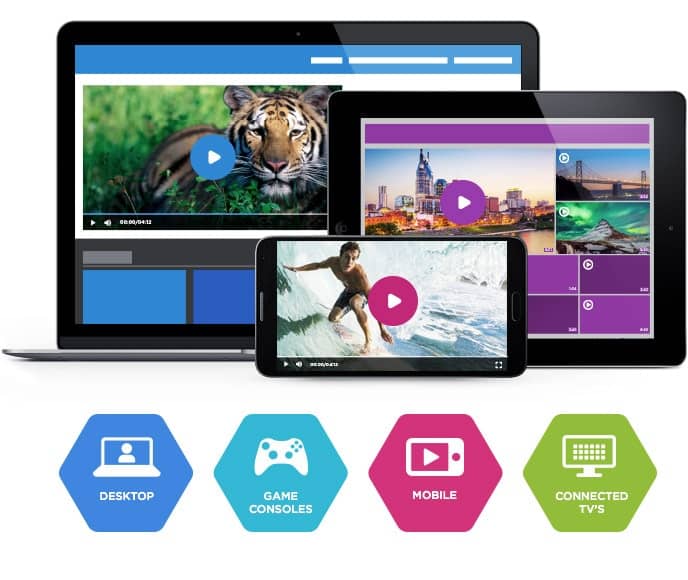
Brightcove is a VOD streaming platform that emphasizes marketing and monetization. It is considered a luxury B2B platform better suited to large enterprises.
Basic Functionality:
Brightcove is a premium B2B video streaming platform emphasizing monetization and marketing.
Key Features:
- Marketing and advertising tools
- Live streaming
- Video analytics built-in
- Video monetization
- Customize your experience with app integrations
Pros:
- Privacy and security tools
- Multiple apps and integrations
- Reliable technical support
- Built-in editing features
Cons:
- Additional cost for 24/7 technical support
- Difficult for beginners to use
Upload Guidelines and Specs:
- Minimum dimension: Determined by user
- Maximum dimension: Determined by user
- Aspect ratio: No restrictions (since Brightcove uses a responsive player)
- Max file size: No limits on files size
- Max video length: No published limits
- Total file storage: Varies by plan
- Compatible video formats: MP4, MOV, FLV, AVI, WMV, MKV, 3GPP
Pricing:
Brightcove offers three pricing plan levels that target higher-end clients.
These three pricing tiers include:
- Starter: includes 50 to 200 videos, up to 100,000 plays, and 2-5 users
- Professional: unlimited videos, 100,000+ plays, and no overages plays, with +10 users
- Enterprise: unlimited videos, 100,000+ plays, and no overages plays, with 10+ users, unlimited upload, and analytics-only users
Brightcove’s pricing is no longer posted, but plans include basic video marketing tools and analytics with SD streaming quality for unlimited viewers.
5. Wowza
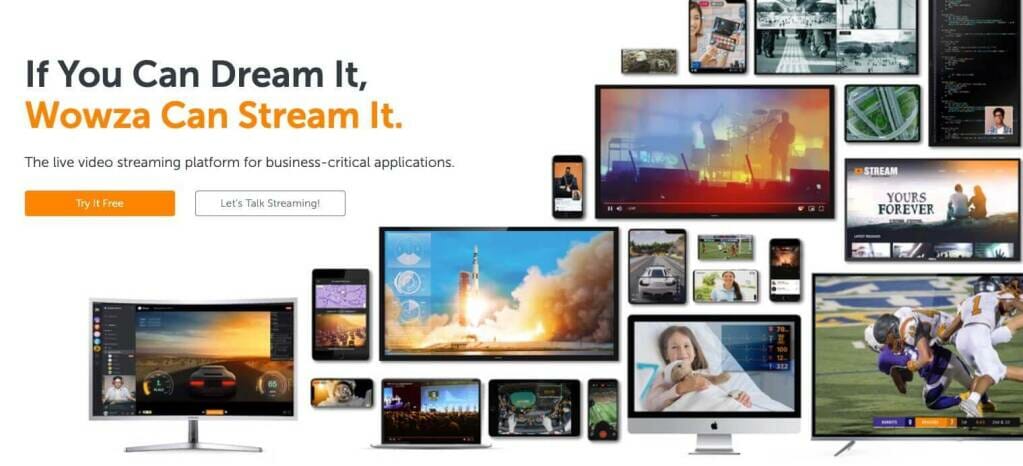
Founded in 2005, Wowza offers video streaming for broadcasters from a wide range of budgets. Some of Wowza’s plans are more expensive and designed for enterprises, they do offer a variety of other more budget-friendly options.
Wowza is well-known for its security features.
Basic Functionality:
Wowza offers two main products. The first is the Wowza Streaming Engine. This product is widely used in the industry for self-hosted streaming. The second is the Wowza Streaming Cloud offering. This functionality includes a variety of features aimed at providing low-latency content access to global audiences.
Key Features:
- Video content management
- Exceptional security features
- High-definition streaming support
- Video API
- Simulcasting capabilities
Pros:
- Streaming on most devices supported
- Powerful security features
- Live streaming and on-demand streaming options
- Connects to Google Analytics
- China video delivery
Cons:
- Monetization only available through integrations
Upload Guidelines and Specs:
- Minimum dimension: 240p (320 x 240)
- Maximum dimension: 4K (3840 x 2160)
- Aspect ratio: 16:9, 4:3
- Max file size: Not available
- Max video length: Not available
- Total file storage: 250 GB (depends on the plan)
- Compatible video formats: MP4, FLV, MP3, SMIL, AMLST, ID3, NGRP
Pricing:
Wowza Streaming Cloud offers 3 distinct pricing plans and services. Within Live Event Pricing, monthly plans include:
- Basic: $99/month and includes 20 hours of live streaming and 1,000 viewing hours based on a video resolution of 720p
- One Month Event: $149 one-time purchase and includes 20 hours of live streaming and 1,000 viewing hours also at 720p
- Plus: $499/month and includes 150 hours of live streaming and 7,000 viewing hours based on a video resolution of 720p
All of these Live Event plans include full brand control, multi-bitrate streaming, and HD and UHD streaming.
The Wowza Streaming Engine has its own pricing plan packages. These professional-grade streaming plans are billed annually and include:
- Basic: $125/month + $145/month for each additional instance and $125/month for each additional prepaid instance
- One Month Event: $245/month + $155/month for each additional instance and $95/month for each additional prepaid instance
- Enterprise: Please contact Wowza directly for access to their custom-tailored high volume enterprise solutions
6. Muvi
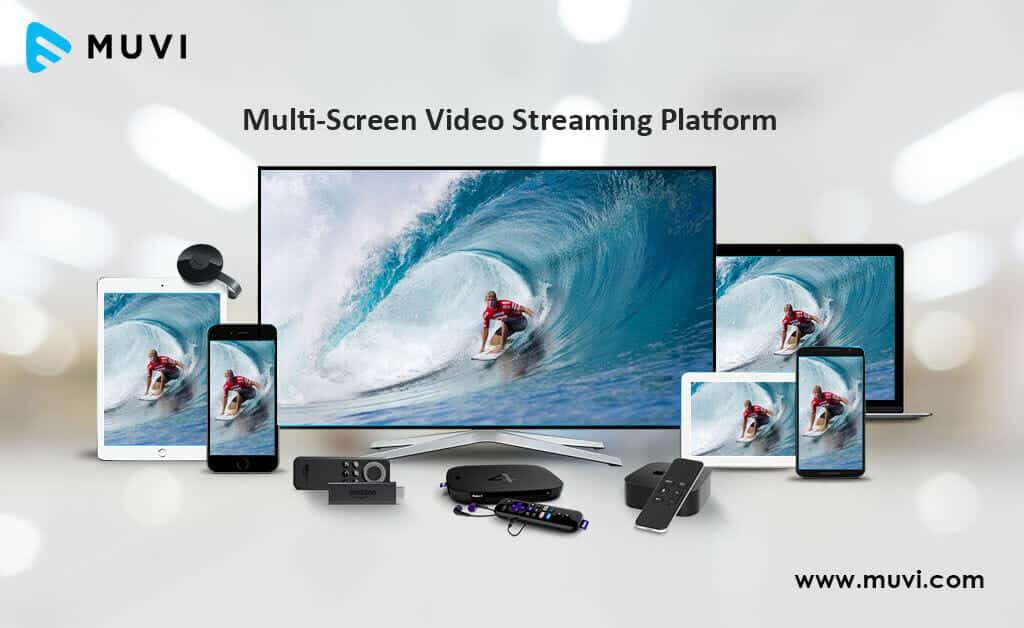
Muvi is an on-demand video platform that is focused on OTT streaming. Muvi’s unique model supports both live and on-demand video streaming and empowers users to launch their own video or audio streaming platform quickly and easily.
Basic Functionality:
Muvi offers fully managed, end-to-end solutions, all controlled from one unified platform. The platform also includes an all-inclusive and fully-featured website, mobile, and TV apps.
Although this provider carries out highly technical functions, it is so well-built that no coding or IT support is required.
Key Features:
- Custom branding
- Comprehensive video CMS
- HTML5 video player
- Video analytics
- Monetization options
- DRM and security features
Pros:
- White-label with branding customization
- Reliable video player
- DRM and security features
- Live and on-demand hosting
- Powerful CDN
- Transcoding tools
- Video streaming security
- Website and Apps for Mobile and TV
Cons:
- Difficulty to integrate external software and apps
- CMS user interface is complex
- Does not support China video delivery
Upload Guidelines and Specs:
- Minimum dimension: 144p (256 x 144)
- Maximum dimension: 4K (3840 x2160)
- Aspect ratio: 16:9, 4:3
- Max file size: not available
- Max video length: not available
- Total file storage: 1TB, 2TB, 5TB (depending on plan)
- Compatible video formats: MP4, MOV, MKV, FLV, VOB, M4V, AVI, 3GP, MPG
Pricing:
Muvi offers five different pricing plans:
- Standard: $399/month (+ $299/month per app + infra fees), allows 2000 concurrent viewers, 1TB of bandwidth, 1 TB of storage, and API access.
- Professional: $1,499 per month (+ $499/month per app + infra fees) increases limits and adds premium support.
- Enterprise: $3,900 per month (+ $499/month per app + infra fees) adds a dedicated server with auto-scaling.
- Ultimate: $8,900/month (+ $499/month per app + infra fees) doubles the bandwidth and storage of the enterprise plan and adds your own CDN and unlimited API calls.
- Black: this is a custom solution and includes everything in the Ultimate plan plus premium services and project management.
7. Wistia
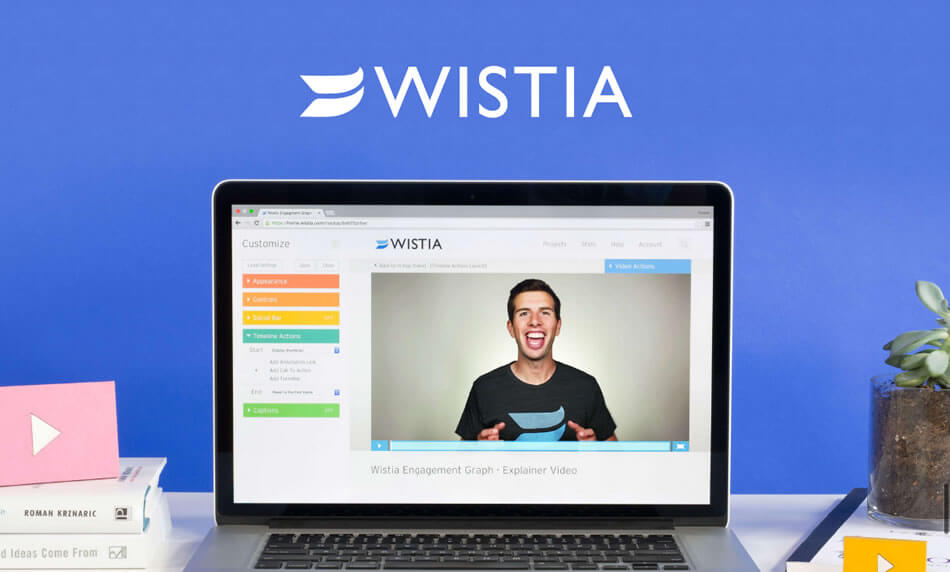
Wistia is an on-demand video streaming service that is designed for broadcasters who need a platform to grow with them as they scale. It is equipped with customizable video players that allow broadcasters to add their logos and branding.
Basic Functionality:
Wistia’s basic functionality is the creation, management, and streaming of video content. Wistia is specifically valuable for marketing since it includes special marketing tools, including CTAs, annotation links, and email features.
Key Features:
- Video management
- Player embedding
- Tools for engagement
- Ad-free streaming
- Channels for organization
- “Up Next” feature
- Reach and retarget
- CRM integrations
- Viewer analytics
- Video SEO
Pros:
- Customizable video player
- Insightful analytics
- Variety of different call to actions
- Automated video SEO
- Improved user experience
- Customer service
Cons:
- Some difficulty with customization options
- No China delivery
Upload Guidelines and Specs:
- Minimum dimensions: None
- Maximum dimensions: Maximum of 4K (3840 x 2160)
- Supported aspect ratios: Any
- Maximum file size: 8 GB
- Maximum video length: 2 hours
- Total file storage: Up to 10 videos with the pro plan ($99 per month), $0.25 per month for every extra video
- Accepted video formats: MP4 (recommended format), .MOV, .AVI, .WMV, .FLV, .MKV, 3GPP
Pricing:
Wistia has three pricing plan tiers.
- Free: No cost to use; up to 250 subscribers and 3 videos; cannot remove Wistia’s branding from the video player
- Pro: $99/month; 10 free videos with additional videos for $0.25/each; white-label video player
- Advanced: custom pricing; 100 free videos with additional videos for $0.25/each; multiple channels, 250+ subscribers
8. Kaltura
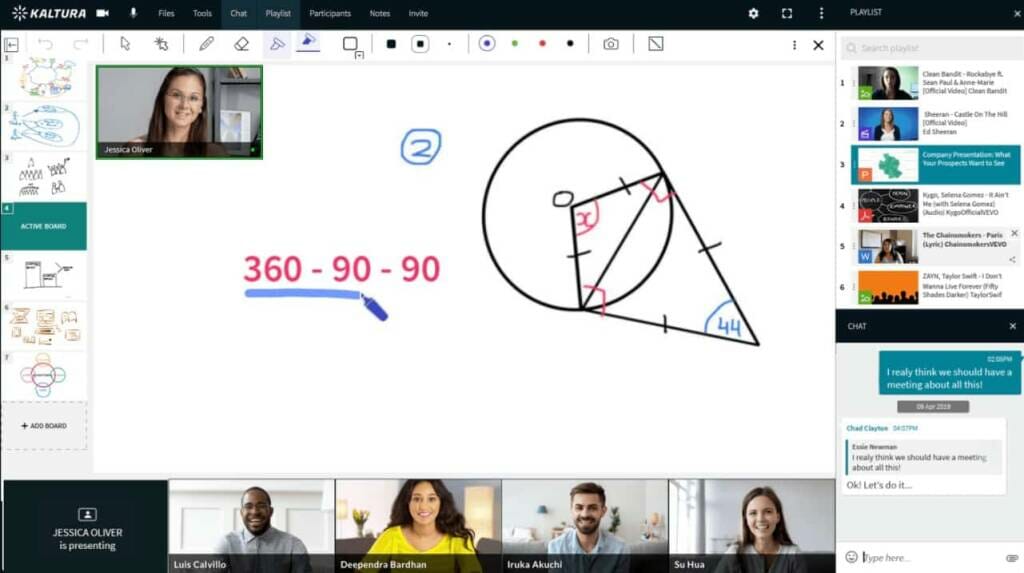
Kaltura is an open-source on-demand video streaming platform that is totally customizable via integrations and plug-ins. Kaltura supports both live and on-demand video streaming.
Basic Functionality:
It is important to note that Kaltura has some differences from other VOD platforms. For example, Kaltura offers a unique ecosystem of functionality and features aimed at large institutions like universities.
Key Features:
- Open-source streaming platform
- Secure streaming (password protection, encryption, and watermarking)
- Multiple monetization options (advertising, subscriptions, and PPV)
- Cloud TV service
- Video looping support
- Closed captioning for accessibility
- Bulk upload tools
Pros:
- Highly customizable
- Suitable for advanced video streaming
- Several monetization options
- Suitable for both internal business use and education use
- Easily accessible for viewers
Cons:
- The platform is a bit complicated
- Some added complexity with the CDN situation
- Some limitations on uploading and processing
- Requires a bit of a learning curve
- No China delivery
Upload Guidelines and Specs:
- Minimum dimension: 180p (320 x 180)
- Maximum dimension: 1080p (1920x 1080)
- Aspect ratio: 16:9, 4:3
- Max file size: 2GB
- Max video length: Not available
- Total file storage: 10GB to Unlimited (depends on the plan)
- Compatible video formats: MOV, MP4
Pricing:
Kaltura’s pricing is based on usage in terms of bandwidth and features. They offer both annual and pay-as-you-go pricing.
You can buy credits to spend that are discounted when purchased in bulk. These commitments start at $5,400. Kaltura also offers a free trial, so broadcasters can try it before they buy.
9. Vidyard

Vidyard is an all-in-one video platform for on-demand streaming. It is specifically geared towards business use. Vidyard’s hosting services are meant to help businesses deliver videos in a professional manner.
Basic Functionality:
This platform offers three major solutions: marketing, sales, and corporate communications. Vidywards tools are set up to help broadcasters turn viewers into customers.
Key Features:
- On-demand video hosting
- Interactive video playback
- Video SEO, playlists, and other organizational tools
- Video customization and personalization
- Custom video-sharing portals and hubs
- Video analytics
- Video privacy and security
Pros:
- Powerful analytics and data reporting
- Reliable customer service
- Wide variety of features
- Solid user community
Cons:
- Backend is not very user friendly
- Inconsistently user reviews
- No China video delivery
Upload Guidelines and Specs:
- Minimum dimension: 360p (480 x 360)
- Maximum dimension: 4k (3840 x 2160)
- Aspect ratio: 16:9, 4:3
- Max file size: 5GB to 16GB (depends on the plan)
- Max video length: 1 hour (live stream)
- Total file storage: Not available
- Compatible video formats: WEBM, MP4, MKV, MOV
Pricing:
There are a few ways to break down Vidyard’s pricing. They have two main umbrellas that their services, and are packaged as follows:
Packages for Individuals and Teams:
- Free Forever: Free
- Pro Package: $15/month; comes with password protection and marketing tools
- Teams Package: $300/month; access for 3 or more users; video analytics and custom branding
- Business Package: $1250/month; access for 5 or more users; custom integrations
Custom Video Solutions:
- All enterprise pricing packages are custom priced.
10. StreamShark
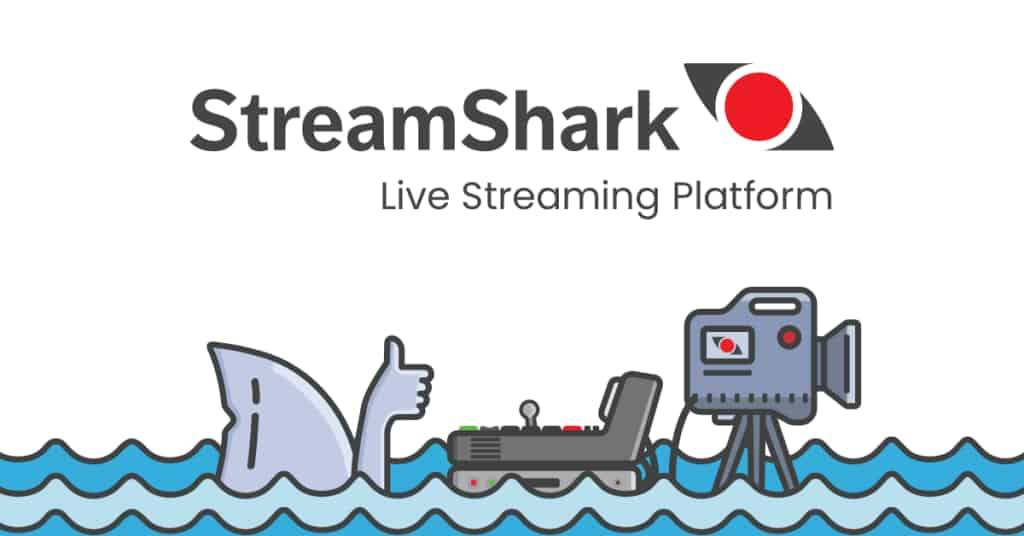
StreamShark is another great on-demand streaming solution that provides multi-faceted online video functionality. This platform is an offering from MetaCDN, so it’s safe to count on StreamShark for fast and reliable content delivery.
Basic Functionality:
StreamShark is designed primarily for large-scale streaming. The unified streaming solution offers users the ability to efficiently different phases of an event’s stream while ensuring maximum reach.
Key Features:
- Global video delivery
- Reliable content delivery
- Mobile streaming support
- Customizable video player
- Privacy tools
- Tech support
Pros:
- Localized media ingestion
- Video encoding support
- Increased video storage space
- Powerful content delivery
Cons:
- Limited organization tools
- Some limitations on analytics
- No China video delivery
Upload Guidelines and Specs:
- Minimum dimension: 240p (426 x 240)
- Maximum dimension: 1080p (1920 x 1080)
- Aspect ratio: 16:9, 4:3
- Max file size: not available
- Max video length: not available
- Total file storage: 500GB, 1TB, 3TB
- Compatible video formats: HLS, WebM VP9, WebM VP8, WebM VP9 DASH, MP4
Pricing:
StreamShark offers several video streaming plans, including:
- Standard: $199/month and include 500 GB of VOD storage an additional overage of $0.10 per GB
- Team: $499/month and includes 2,000 GB of storage, and lowers per GB overage prices to $0.09
- Business: $999/month and includes 5,000 GB of storage, and reduces the overage to $0.08 per GB
Please contact StreamShark directly for their custom-priced enterprise solutions.
11. JW Player
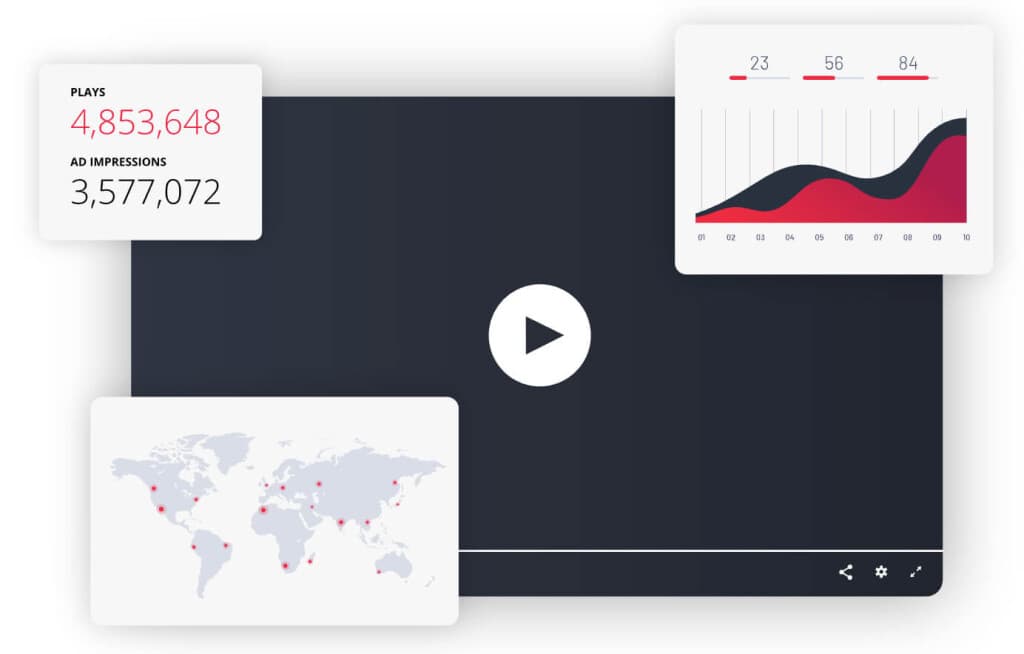
Today, JW Player is a professional VOD streaming platform, but its technology once shared some of its code with the original Youtube video player.
Basic Functionality:
While JW is a solid platform and a great video player, it has a few noteworthy drawbacks. JW Player is budget-friendly, but its feature offering reflects that. It is a viable option if you have a limited budget or have minimal streaming needs.
Key Features:
- Powerful HTML5 video player
- Secure video streaming
- Affordable streaming plans
- Insightful video analytics
- Video distribution management
Pros:
- Integrations for advertising monetization
- All-device streaming
- Basic user interface
- Very affordable
- Great customer service
- Excellent sales support
Cons:
- Limited monetization tools
- No closed captioning
- Streams via internal server
- Does not support China delivery
Upload Guidelines and Specs:
- Minimum dimension: 360p (640 x 360)
- Maximum dimension: 1080p (1920 x 1080)
- Aspect ratio: 16:9, 4:3, 2.39:1
- Max file size: 25GB
- Max video length: Not available
- Total file storage: 25GB to 500GB (depends on the plan)
- Compatible video formats: MP4, WMV, AVI, MOV, 3GP, FLV
Pricing:
JW Player has pricing plans which range from free to paid with numerous benefits and features. These packages include:
- Free trial: JW Player offers a 30-day free trial subscription which includes full API and SDK access, a non-commercial license, 25 GB hosting bandwidth, and 75 GB streaming.
- Starter: At $10 per month, the Starter pricing plan includes an HTML5 Video Player, a video gallery, with 150 GB hosting bandwidth, and 500 GB streaming (50,000 plays) per month (billed annually).
- Enterprise: these business-specific plans are available with custom pricing for high-volume storage and streaming. Enterprise plans support live streaming, while lower-tier plans only support VOD.
12. VPlayed
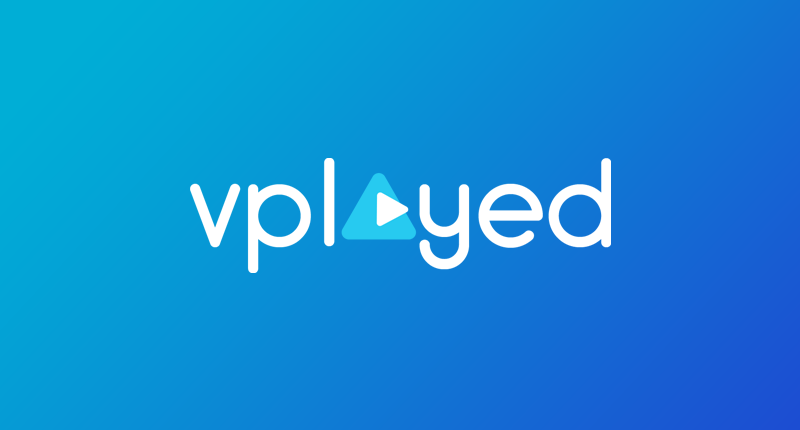
VPlayed is an on-demand streaming platform that offers solutions for enterprises, churches, sports broadcasters, education, filmmakers, and more. It offers both live and on-demand video streaming.
Basic Functionality:
Streaming on VPlayed is powered by OTT technology. This platform is equipped with all of the features that broadcasters need for a professional streaming experience.
Key Features:
- Live and on-demand video streaming
- Tools for marketing
- Comprehensive video CMS
- Adaptive bitrate streaming
- Multiple monetization options with a secure paywall
- Advanced video security (SLS encryption, password protection, DRM, etc.)
Pros:
- Reliable video security
- Tools for engagement and interaction
- Highly customizable solution
- Easy to use platform
Cons:
- No pricing transparency
- No free trial
- Limited analytics
Upload Guidelines and Specs:
- Minimum dimension: Not available
- Maximum dimension: Not available
- Aspect ratio: Not available
- Max file size: Unlimited
- Max video length: Not available
- Total file storage: Unlimited
- Compatible video formats: MP4, 3GP, MOV, MPEG-TS, MPEG-2 PS, MPEG1, and more
Pricing:
All plans are custom priced, so please contact VPlayed directly for pricing information.
13. YouTube

YouTube is a consumer-grade VOD streaming platform that is best suited for broadcasters who have minimal streaming needs. It supports both VOD and live streaming, but the most popular content on the platform is on-demand videos.
Basic Functionality:
YouTube is not the best option for enterprise streaming, but it is commonly used by small businesses and start-ups that don’t have the budget for a professional solution.
Key Features:
- Ad-based monetization (with limitations)
- No real security features
- Very popular among viewers
- Owned by Google
- Easy to embed and share videos
- No white-label streaming
Pros:
- Popular among consumers
- Free to use (for both viewers and broadcasters)
- YouTube is a household name, so viewers are comfortable using it
- Easy to share videos
- Easy to use (for both viewers and broadcasters)
Cons:
- Cannot remove YouTube’s branding
- Strict restrictions on content
- No notable security features
- YouTube owns partial rights to your content
- Distracting third party ads and branding
- Highly restricted ad-based monetization
Upload Guidelines and Specs:
- Minimum dimension: 240p (426 x 240)
- Maximum dimension: 4K (3840 x 2160)
- Aspect ratio: 16:9 (adds padding to videos with other aspect ratios)
- Max file size: 128 GB
- Max video length: 12 hours
- Total file storage: No storage limit
- Compatible video formats: MP4, MOV, MPEG4, FLV, AVI, Web M, WMV, MPEG-PS, 3GPP
Pricing:
YouTube is free to use.
14. Dailymotion

Dailymotion is another consumer-grade on-demand streaming platform that is very similar to YouTube. One thing that many broadcasters like about Dailymotion is that it is very lax on the type of content that can be streamed.
Basic Functionality:
Dailymotion is a basic platform for beginner broadcasters that need a simple platform to upload and host video content. Since this site is free, it is pretty “bare bones” in terms of professional broadcasting tools.
Key Features:
- On-demand video hosting
- Basic video platform
- Based in France
- Small creator fund
- Lax content restrictions
- Professional partnership programs
Pros:
- Copyright protection is included
- Very few content restrictions
- Becoming more popular around the world
Cons:
- Not as popular as YouTube
- No real monetization tools
- Limited video analytics
Upload Guidelines and Specs:
- Minimum dimension: 240p (426 x 240)
- Maximum dimension: 4K (3840 x 2160)
- Aspect ratio: 16:9 (adds padding to videos with other aspect ratios)
- Max file size: 128GB
- Max video length: 12 hours
- Total file storage: Unlimited
- Compatible video formats: MOV, MPEG4, MP4, AVI, WMV, MPEG-PS, FLV, 3GPP, WebM
Pricing:
Dailymotion is free to use.
15. Facebook

When it comes to on-demand video hosting, Facebook offers a feature called “Facebook Watch.” Facebook Watch videos can only be published by users with a Facebook Page.
Since it is a free platform, Facebook poses many challenges related to video ownership, time limits on videos, monetization, and more. For these reasons, it is typically used by small businesses and organizations with small budgets or minimal streaming needs.
Aside from those few technical restrictions, live streaming with Facebook Live is valuable for connecting with existing audiences.
Basic Functionality:
It is common for broadcasters who use paid streaming solutions to connect their accounts to multicast to both Facebook and their websites. This allows users to tap into their existing Facebook audiences while accessing the professional tools of a video hosting solution.
Key Features:
- Facebook Watch
- Business Groups & Pages
- Simple video sharing
- Support for live engagement
- Some simple business tools
Pros:
- Free to use
- Familiar among consumers
- Live chat feed promotes engagement
- Helps reach your existing following
Cons:
- Limited monetization options
- Cannot remove Facebook’s branding
Upload Guidelines and Specs:
- Minimum dimension: 720p (1280×720)
- Maximum dimension: 1080p (1920×1080)
- Aspect ratio: 16:9, 9:16, 2:3, 4:5, 1:1
- Max file size: 4 GB
- Max video length: 90 minutes
- Total file storage: No storage limit
- Compatible video formats: MP4, MOV, MPEG4, AVI, 3GPP, WMV, FLV, MKV
Pricing:
Facebook is free to use.
Conclusion
Using on-demand video streaming allows you the greatest access to a lasting audience. It is powerful because it gives viewers the option to view your content whenever they want. It also allows them to pause and rewatch on their own schedule, which is definitely a plus.
Choosing the right on-demand video streaming platform will enhance your video streaming experience. However, with so many options available, making a decision may feel like a daunting task. We recommend taking advantage of free trials to test out different platforms that meet your criteria.
If you want to take the next step in VOD streaming, try Dacast free for 14 days. You’ll have no long-term contract to sign and no hefty start-up fees to pay, and we don’t require a credit card to get started.
Thanks for reading. If you have any questions or experiences to share, please let us know in the comments. And for regular tips on live streaming, join our LinkedIn group.
 Stream
Stream Connect
Connect Manage
Manage Measure
Measure Events
Events Business
Business Organizations
Organizations Entertainment and Media
Entertainment and Media API
API Tools
Tools Learning Center
Learning Center Support
Support Support Articles
Support Articles